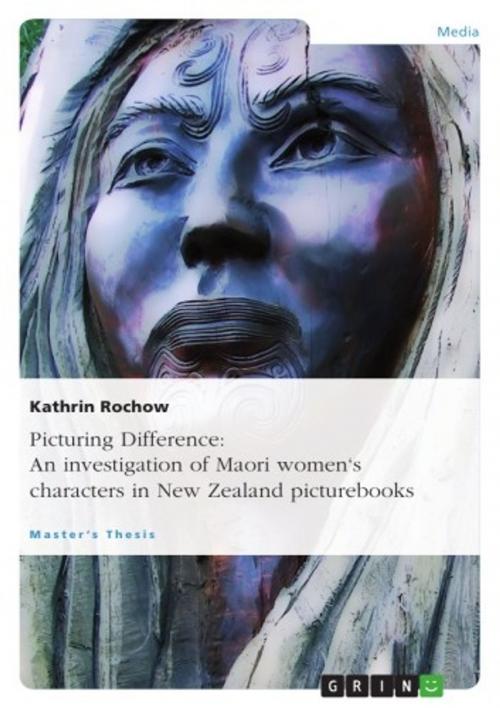Picturing Difference: An investigation of Maori women's characters in New Zealand picturebooks
Nonfiction, Reference & Language, Language Arts, Communication| Author: | Kathrin Rochow | ISBN: | 9783656323754 |
| Publisher: | GRIN Verlag | Publication: | November 28, 2012 |
| Imprint: | GRIN Verlag | Language: | English |
| Author: | Kathrin Rochow |
| ISBN: | 9783656323754 |
| Publisher: | GRIN Verlag |
| Publication: | November 28, 2012 |
| Imprint: | GRIN Verlag |
| Language: | English |
Master's Thesis from the year 2011 in the subject Communications - Miscellaneous, grade: 1,0, Uppsala University, language: English, abstract: Children's books have been around since the early 1500s. They reflect the traditional values of the times, yet they still serve as a socializing tool transmitting values from one generation to the next in today's society (Gooden and Gooden 2001). Only in the latter years of the twentieth century has the picturebook become a serious object of academic study (Lewis 2001). Researchers began to take notice of the (under-)representation of women in children's books and asserted commonly that reducing sexism in children's reading materials is crucial for developing an equitable and democratic society. Although previous research has examined the representation of gender and race in children's literature extensively, there is, however, a major gap, focusing on the portrayal of New Zealand's indigenous Polynesian people - specifically, the Maori woman. Little is known about the visibility of Maori women in print media (Evans 1994) and even less about their depiction in children's picturebooks. In order to address this gap in the literature, this paper investigates the visual and verbal representation of Maori women in contemporary New Zealand picturebooks. Following the theories of Peter L. Berger, Thomas Luckmann and George Herbert Mead I developed a model illustrating the circular process of picturebook communication. Moreover those theories serve as a theoretical framework, constituting the subsequent content analysis. As I examined the characters of Maori women in different New Zealand picturebooks, I identified three typifications, constituting the identity of an indigenous New Zealand woman in those narratives. The Teacher, the Entertainer and the Spiritual Maori woman reinvent and reproduce, yet delimit and constrain the identity of Maori women in contemporary picturebooks. Those books fail to intertwine and integrate the two differing cultures of Maori and Pakeha (New Zealander of European descent), in their storyline, and neglect current struggles or conflicts in the social reality of New Zealand. Based on one outstanding book, I drew the conclusion that it is through integrating the two differing symbolic universes of Pakeha and Maori into the storyline, that the multiple roles carried by Maori women can be acknowledged and an authentic portrayal of Maori women is achieved.
Master's Thesis from the year 2011 in the subject Communications - Miscellaneous, grade: 1,0, Uppsala University, language: English, abstract: Children's books have been around since the early 1500s. They reflect the traditional values of the times, yet they still serve as a socializing tool transmitting values from one generation to the next in today's society (Gooden and Gooden 2001). Only in the latter years of the twentieth century has the picturebook become a serious object of academic study (Lewis 2001). Researchers began to take notice of the (under-)representation of women in children's books and asserted commonly that reducing sexism in children's reading materials is crucial for developing an equitable and democratic society. Although previous research has examined the representation of gender and race in children's literature extensively, there is, however, a major gap, focusing on the portrayal of New Zealand's indigenous Polynesian people - specifically, the Maori woman. Little is known about the visibility of Maori women in print media (Evans 1994) and even less about their depiction in children's picturebooks. In order to address this gap in the literature, this paper investigates the visual and verbal representation of Maori women in contemporary New Zealand picturebooks. Following the theories of Peter L. Berger, Thomas Luckmann and George Herbert Mead I developed a model illustrating the circular process of picturebook communication. Moreover those theories serve as a theoretical framework, constituting the subsequent content analysis. As I examined the characters of Maori women in different New Zealand picturebooks, I identified three typifications, constituting the identity of an indigenous New Zealand woman in those narratives. The Teacher, the Entertainer and the Spiritual Maori woman reinvent and reproduce, yet delimit and constrain the identity of Maori women in contemporary picturebooks. Those books fail to intertwine and integrate the two differing cultures of Maori and Pakeha (New Zealander of European descent), in their storyline, and neglect current struggles or conflicts in the social reality of New Zealand. Based on one outstanding book, I drew the conclusion that it is through integrating the two differing symbolic universes of Pakeha and Maori into the storyline, that the multiple roles carried by Maori women can be acknowledged and an authentic portrayal of Maori women is achieved.















